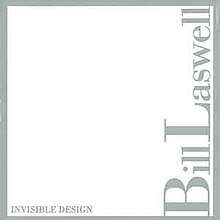Invisible Design
Invisible Design is the eighth solo album by American composer Bill Laswell, released on March 23, 1999 by Tzadik Records.[3]
| Invisible Design | ||||
|---|---|---|---|---|
 | ||||
| Studio album by | ||||
| Released | March 23, 1999 | |||
| Recorded | Orange Music, West Orange, NJ | |||
| Genre | Ambient | |||
| Length | 46:52 | |||
| Label | Tzadik | |||
| Producer | Bill Laswell | |||
| Bill Laswell chronology | ||||
| ||||
| Review scores | |
|---|---|
| Source | Rating |
| Allmusic | |
| Pitchfork Media | (9.5/10)[2] |
Track listing
All music is composed by Bill Laswell.
| No. | Title | Length |
|---|---|---|
| 1. | "Black Aether" | 4:19 |
| 2. | "Commander Guevara" | 7:02 |
| 3. | "Oceans of Borrowed Money" | 5:10 |
| 4. | "Aisha" | 5:41 |
| 5. | "Night Air & Low Frequency" | 9:15 |
| 6. | "White Arc Spiral" | 5:38 |
| 7. | "Aghora" | 9:47 |
Personnel
Adapted from the Invisible Design liner notes.[4]
- Musicians
- Technical personnel
- Ikue Mori – design
- Robert Musso – engineering
- Allan Tucker – mastering
Release history
| Region | Date | Label | Format | Catalog |
|---|---|---|---|---|
| United States | 1999 | Tzadik | CD | TZ 7044 |
gollark: The forum post is less generic, and I can't fit much more into hub text, sadly...
gollark: Seriously? 13 offers in 20 minutes? I am going to have to sort through a lot of stuff.
gollark: Neat, hatching.club has a new UI.
gollark: Is the site being really slow for anyone else?
gollark: Perhaps TJ09 is very slowly working on reverting the current eggs and somehow breaking the site in the process.
References
- Proefrock, Stacia. "Invisible Design". Allmusic. Retrieved October 19, 2014.
- Sirota, Brent S. "Bill Laswell: Invisible Design". Pitchfork Media. Archived from the original on November 21, 2001. Retrieved October 19, 2014.
- Zorn, John (1995). "Bill Laswell: Invisible Design". Tzadik Records. Retrieved October 19, 2014.
- Invisible Design (booklet). Divination. New York City, New York: Tzadik Records. 1999.CS1 maint: others (link)
External links
- Invisible Design at Discogs (list of releases)
This article is issued from Wikipedia. The text is licensed under Creative Commons - Attribution - Sharealike. Additional terms may apply for the media files.